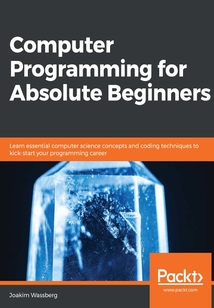舉報 

會員
Computer Programming for Absolute Beginners
Learninghowtocodehasmanyadvantages,andgainingtherightprogrammingskillscanhaveamassiveimpactonwhatyoucandowithyourcurrentskillsetandthewayyouadvanceinyourcareer.Thisbookwillbeyourguidetolearningcomputerprogrammingeasily,helpingyouovercomethedifficultiesinunderstandingthemajorconstructsinanymainstreamprogramminglanguage.ComputerProgrammingforAbsoluteBeginnersstartsbytakingyouthroughthebuildingblocksofanyprogramminglanguagewiththoroughexplanationsandrelevantexamplesinpseudocode.You'llunderstandtherelationshipbetweencomputerprogramsandprogramminglanguagesandhowcodeisexecutedonthecomputer.Thebookthenfocusesonthedifferenttypesofapplicationsthatyoucancreatewithyourprogrammingknowledge.You'lldelveintoprogrammingconstructs,learningallaboutstatements,operators,variables,anddatatypes.Asyouadvance,you'llseehowtocontroltheflowofyourprogramsusingcontrolstructuresandreuseyourcodeusingfunctions.Finally,you'llexplorebestpracticesthatwillhelpyouwritecodelikeapro.Bytheendofthisbook,you'llbepreparedtolearnanyprogramminglanguageandtakecontrolofyourcareerbyaddingcodingtoyourskillset.
目錄(103章)
倒序
- 封面
- 版權信息
- Why subscribe?
- Contributors About the author
- About the reviewer
- Packt is searching for authors like you
- Preface
- Section 1: Introduction to Computer Programs and Computer Programming
- Chapter 1: Introduction to Computer Programs
- A brief history of computing
- A brief history of programming
- What is a program?
- Understanding the binary system
- Summary
- Chapter 2: Introduction to Programming Languages
- Why do we have programming languages?
- How programming languages have evolved?
- The family tree of programming languages
- Translating code into something that the computer understands
- Syntax and the building blocks of a programming language
- Summary
- Chapter 3: Types of Applications
- Standalone applications
- Client-server applications
- Web applications
- Mobile applications
- Distributed applications
- Cloud-based applications
- Other types of applications
- Summary
- Chapter 4: Software Projects and How We Organize Our Code
- Code modules
- Working with software projects
- Working with packages to share code
- Avoiding conflicts using namespaces
- Summary
- Section 2: Constructs of a Programming Language
- Chapter 5: Sequence – The Basic Building Block of a Computer Program
- The importance of sequences
- Summary
- Chapter 6: Working with Data – Variables
- Declaring and initializing variables
- Primitive data types
- Composite type
- Summary
- Chapter 7: Program Control Structures
- Controlling the execution path
- Selection with the if statement
- Selection with the switch statement
- Iteration with the for loop
- Iteration with the while loop
- Iteration with the do while loop
- Iterating over sequences using for each
- Summary
- Chapter 8: Understanding Functions
- Deciding what goes into a function
- Writing a function
- Returning values from a function
- Function arguments
- Functions in action
- Local and global variables
- Summary
- Chapter 9: When Things Go Wrong – Bugs and Exceptions
- Understanding software bugs
- Understanding types of software bugs
- Finding bugs using a debugger
- Handling exceptions
- Summary
- Chapter 10: Programming Paradigms
- Understanding structured programming
- Understanding object-orientated programming
- Understanding functional programming
- Understanding logic programming
- Other paradigms
- Multi-paradigm languages
- Summary
- Chapter 11: Programming Tools and Methodologies
- Understanding version control systems
- Unit testing
- Integration testing
- Other types of tests
- Software releases
- Understanding software deployment
- Software development process methodologies
- Summary
- Section 3: Best Practices for Writing High-Quality Code
- Chapter 12: Code Quality
- Defining code quality
- Writing code with readability in mind
- Writing code with efficiency in mind
- Is smart code smart?
- Code quality – best practices
- Summary
- Appendix A: How to Translate the Pseudocode into Real Code
- The pseudocode examples
- C++
- C#
- Java
- JavaScript
- PHP
- Python
- Appendix B: Dictionary
- Other Books You May Enjoy 更新時間:2021-06-11 18:38:53
推薦閱讀
- Java Data Science Cookbook
- 數據之巔:數據的本質與未來
- App+軟件+游戲+網站界面設計教程
- 云計算服務保障體系
- 區塊鏈通俗讀本
- 大話Oracle Grid:云時代的RAC
- Python醫學數據分析入門
- 數字媒體交互設計(初級):Web產品交互設計方法與案例
- 數據中心數字孿生應用實踐
- SIEMENS數控技術應用工程師:SINUMERIK 840D-810D數控系統功能應用與維修調整教程
- Oracle 11g+ASP.NET數據庫系統開發案例教程
- Delphi High Performance
- 代碼的未來
- Unity 4.x Game AI Programming
- 2D 計算機視覺:原理、算法及應用
- 工業大數據工程:系統、方法與實踐
- Java Deep Learning Essentials
- 大數據背景下的Web層次化話題檢測與跟蹤關鍵技術研究及應用
- 網站數據挖掘與分析:系統方法與商業實踐
- 社交網站的數據挖掘與分析(原書第3版)
- 網絡科學與網絡大數據結構挖掘
- Visual C# 2005+SQL Server 2005數據庫與網絡開發
- Spark大數據處理:技術、應用與性能優化
- Power BI數據分析與數據可視化(微課版)
- iPhone Location Aware Apps by Example -Beginners Guide
- 云計算與大數據
- Hands-On Web Scraping with Python
- 數據庫技術及應用(Access)實驗指導與習題集
- Oracle RAC核心技術詳解
- 可視化分析與SAS實現

